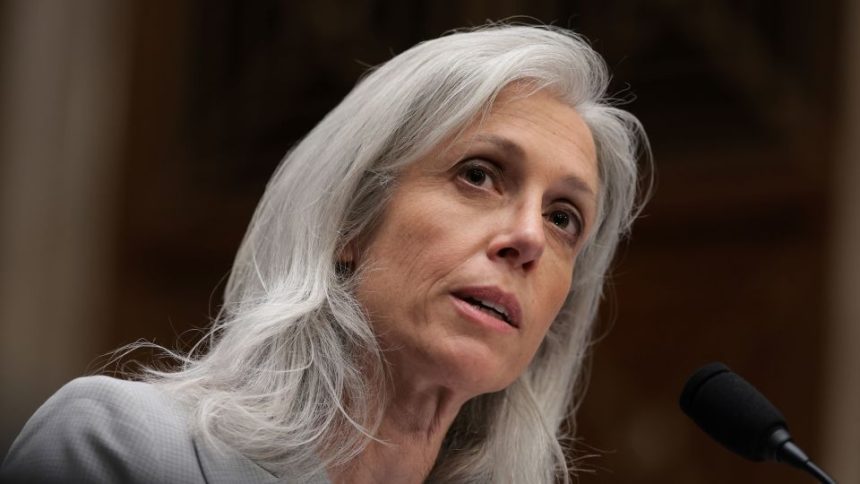Maryland State Superintendent Carey Wright talks with a student at Gov. Thomas Johnson High School in Frederick County on Aug. 20, as she and other local and state education officials visited on the first day of school of the 2025-26 school year for the county. (Photo by William J. Ford/Maryland Matters)
Maryland public school students made modest gains in math and English language arts, but significant gaps remain between demographic groups, the latest test results show.
The Maryland Comprehensive Assessment Program (MCAP), which students took this spring, showed nearly 51% of students were proficient in language arts, an increase from about 48% in the 2023-24 school year.
The results mark the third straight year of language arts increases, gains that are being attributed in part to the “science of reading” curriculum that State Superintendent Carey Wright brought with her from Mississippi, where test scores rose significantly while she was superintendent there.
Fourth grade was the only level that saw their overall scores go down, form 49.3% in the 2023-24 school year to 48.4% in 20240-25, according to results reviewed Tuesday by the state Board of Education.
Math scores also rose, but they remained far behind language arts: About 26.5% of students were proficient in math, versus 24% in the previous school year.
The board approved a revision of math standards, and parts of a math policy will be implemented this year, which should help improve student outcomes, said Tenette Smith, chief academic officer with the state Department of Education.
“We are seeing progress, but there’s still important work” to be done, Smith said.
The data are from tests taken by students in the spring in grades three through eight in math and language arts. Language arts is also assessed in 10th grade. Student proficiency is also measured in specific math courses and in science for students in fifth and eighth grades.
At least two board members expressed concerns about the gaps between student groups, specifically Black and Latino students.
The biggest gap, according to the exam results, game in eighth grade science.
About 62% of Asian students were proficient in that subject last school year, compared to 53% in the 2023-24 school year. White student proficiency rose from 40% to nearly 49% in the same period. While other student groups also made progress, they still trailed:
-
Latino students went from 11.7% proficiency in 2023-24 to 17.1% last school year;
-
Black students rose from 12.3% in 2023-24 to 17% last school year.
Board member Alverne “Chet” Chesterfield asked why the same “set of folks still underperforming.” That was echoed by board member Nick Greer, who noted that the same concern was expressed last year and who asked what strategies will be looked at in the near future to help close those achievement gaps.
With the exception of language arts, the proficiency level for students with disabilities and multilingual students didn’t reach double digits.
“What we need to be doing as a state and as superintendents and principals … is identifying those specific children that were still struggling regardless what subgroup they’re in,” said Wright, the state superintendent, during a briefing with reporters Tuesday afternoon. “You’ve got to look at individual children, because each child’s needs are very individual, and that’s what we’re expecting schools to do.”
School systems vary
Worcester County, which recorded the second-highest proficiency level in math at 39.3% in 2023-24 school year, moved into first place last year with a rate of 47.7%. Despite a drop from 69.4% two years ago, Worcester County still had the highest English proficiency last year, at 68.5%.

One reason for that jurisdiction being the best in Maryland comes from consistent leadership, said state board President Joshua Michael. Worcester County school board member Jon Andes also was the school system’s superintendent from 1996 to 2012.
“This is a school district over decades that has had very few superintendents,” Michael said. “So there is a level of instructional coherence in that district. There’s a level of continuity in leadership.”
Just behind Worcester in math proficiency is Howard County, which recorded its students’ proficiency in math at 42%, pu from 41.1% two years ago.
Carroll County students had the second highest proficiency in English at 66.5%. Students in Dorchester County saw the biggest increase in English scores, rising from 33.7% to 41.3%.
Although Somerset County recorded the lowest student proficiency in math last school year at 10.1%, that was an improvement from the 9.8% recorded two years ago.
Despite the gains, lawmakers missed an opportunity to make scores even higher in the future, said Trish Brennan-Gac, executive director of Maryland READS, in an interview Tuesday.
The General Assembly approved a training program within the Excellence in Maryland Public Schools Act during this year’s 90-day legislative session. But no funding was attached to the program educators call a “coaching program.”
“We will not see as dramatic improvement in reading instruction in 2026 as we could have,” Brennan-Gac said. “Had the legislature funded that program, they would have been able to establish the coaching program this summer, train the coaches and begin to have them supporting teachers in the classroom this year, which means by the spring, when the MCAP scores were administered, students are more likely to have had better reading instruction and have reading proficiency rates increase.
“So next year, we will probably, hopefully see the same continued weak trend instead of a dramatic improvement,” she said. “So, if we want to see that dramatic improvement, then we have to get the coaching funded.”













